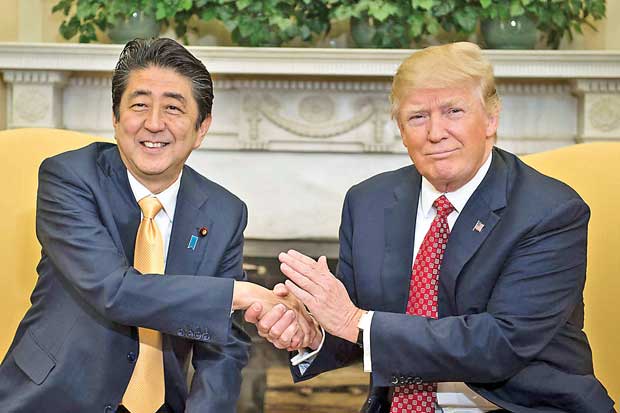06 Sep 2017 - {{hitsCtrl.values.hits}}

By Sheila A. Smith
In November 2017, there was a great deal of uncertainty about the newly elected US President Donald Trump and his approach to foreign policy. Nine months later, there is little evidence that the Trump administration will craft a definitive foreign policy for Asia. Rather, it seems increasingly likely that the US policy towards Asia will be reactive rather than prescriptive, framed by Trump’s transactional ambitions on trade and counterbalanced by the United States’ long-standing security alliances.
But for the foreseeable future, we can discern some characteristics of the Trump administration that are likely to shape its approach to allies and adversaries alike.
First, Trump prefers solving problems through bilateral channels. In the early months of his presidency, Trump made it clear that multilateral venues are not his thing. The North Atlantic Treaty Organisation (NATO) and G20 meetings with European allies revealed a US president who found the formalities of multilateral diplomacy tiresome and awkward. US allies were shocked at Trump’s deliberate decision to forego the NATO’s Article Five assurances (on collective self-defence) and were similarly uncomfortable with the Trump administration’s ‘America First’ agenda, dramatically symbolised by the US withdrawal from the Paris Agreement.
Second, President Trump seems uninterested in the regional expertise of government or outside experts and instead relies on his instincts and briefing insights from foreign leaders. Few are in the room when he meets with other leaders, creating a chasm between the White House and bureaucracy.
Finally, the US foreign policy is badly served by the Trump administration’s unwillingness to nominate senior staff to carry out his foreign policy and security agenda. The Departments of Defence and State continue to operate without political appointees in charge of the Asia bureaus and the Department of State is abysmally understaffed, leaving the US government unprepared to execute foreign policy.
Looking ahead, difficulties and uncertainty abound for the Trump administration’s approach to Asia. Trump’s management of the North Korean crisis has deepened anxiety in Tokyo and Seoul. While the Secretaries of State and Defence have worked to calm the region’s war jitters, Trump upped the ante, threatening ‘fire and fury like the world has never seen’. The regime in Pyongyang is known for its fiery rhetoric, but a US president is hardly expected to join in on a game of brinksmanship that could trigger war on the Korean peninsula.
In November, 18 Asian leaders will gather at the East Asia Summit. Unlike Europe, Asia is contested and Trump will not have the luxury of sitting with US allies alone. Sparring with China has become the norm of late in Association of Southeast Asian Nations (ASEAN)-sponsored multilateral gatherings, but this time all eyes will be on how President Xi Jinping and Trump perform. Xi will be seeking to demonstrate to his neighbours that China rather than the US should lead in Asia and he too will likely feel pressure from home as he readies for the Chinese Communist Party’s 19th National Congress.
At the APEC Summit — also in November — Trump will find himself face to face with the United States’ dissatisfied Asian trading partners and, just like in Hamburg, he is likely to be the odd man out. Trump’s decision to withdraw from the Trans-Pacific Partnership (TPP) has sidelined the United States in the regional trade talks that are so important in Asia and even US allies will not rally behind Trump at APEC meetings.
The remaining 11 TPP nations are forging ahead without the United States and they intend to push their agenda forward. The Trump administration may wish to set up meetings to discuss bilateral trade interests, but, like at the G20, his team will be isolated. For most Asian nations, the top priority now is to consider a future regional trading order without the United States and how to ensure that China will not be able to define it by default.
All of this complex diplomacy will undoubtedly be affected by turbulent politics at home. Once again, the US government seems on the verge of a shutdown. After Charlottesville reopened the wounds of racial violence in the United States, the Republican Party seems deeply divided. To rub salt in those wounds, Trump’s insistence on the Mexican border wall has complicated his own party’s ambitions for the fiscal and tax reforms long promised to their constituents.
There is an opportunity here, if this administration wants it. Trump could counter the impression that his administration is too busy at home to focus on its global interests. He could reassure US partners and allies to remain confident in US leadership. But bluster will not work in this setting. Already, Asian concerns are deepening about a region with a United States adrift. Trump’s trade rhetoric has alienated many of the smaller powers and recent accidents by the US Navy’s 7th Fleet in Asian waters have created the impression that even Washington’s military power is faltering.
Questions that might lead to a debate over US strategic priorities in Asia — such as how should Washington contend with the ever-rising influence of China, how US influence can be leveraged in the service of regional peace and prosperity and how the US can build collective responses to regional economic and military challenges — are simply not being asked in Washington.
A Trumpian grand strategy seems ever more remote, and long-standing US partnerships in Asia seem at considerable risk. Care must be taken that Asian friendships do not become the collateral damage of a failed recalibration of democracy.
Asia, like Europe, may have to move on without the United States for now.
(Sheila A. Smith is senior fellow for Japan studies at the Council on Foreign Relations)
25 Nov 2024 8 minute ago
25 Nov 2024 33 minute ago
25 Nov 2024 1 hours ago
25 Nov 2024 1 hours ago
25 Nov 2024 1 hours ago